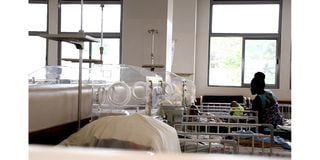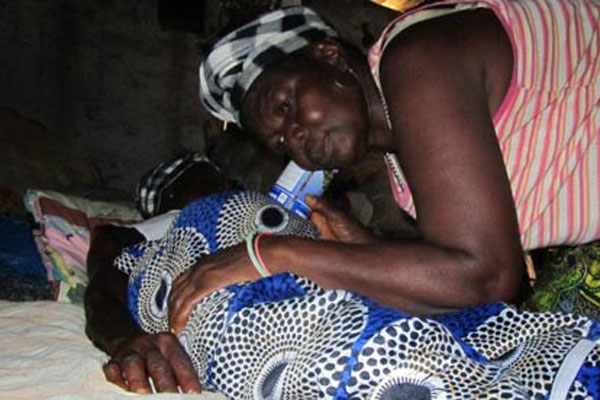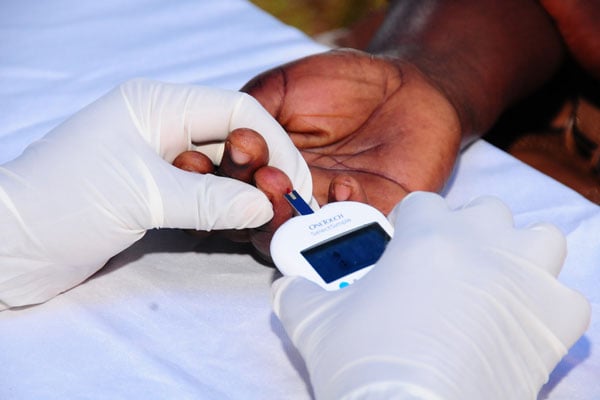Prime
Acholi makes strides in mother-to-child HIV fight

A mother attends to her newborn baby at Gulu Regional Referral Hospital maternity unit. PHOTO | TOBBIAS JOLLY OWINY
What you need to know:
- Through rigorous antenatal care, early HIV testing, nevirapine prophylaxis administration, and ensuring adherence to treatment regimens by both mothers and their partners, transmission of HIV/Aids has significantly reduced.
Holding a small white plastic bottle and breastfeeding her five-month-old daughter, Ms Jessica Arach draws a cup to tap water from a nearby jar with which she swallows a dose of Anti-Retroviral (ARVs) medicine.
Inside the bottle, are ARV tablets, a drug she has been taking to suppress her viral load. This time, she takes them with extra care to ensure the viral load gets so low to lessen the risk of potentially infecting her newborn child.
Five years ago, she was diagnosed with HIV/Aids, at Gulu Regional Referral Hospital before delivering her firstborn.
Arach was advised to start treatment to avoid transmitting the virus to her unborn baby.
“Finishing my diploma course from Gulu University was a tough one and my parents declined to pay my tuition for the last semester because they had lost all hope in me,” Anena recounts.
Her firstborn was declared free of the infection at 10 months and she was asked by the health workers from Gulu Regional Referral Hospital to stop breastfeeding.
“I am hopeful that with the counselling I get regularly, in the next few months, I will wean my daughter free of the disease. I don’t care if my profession as an accountant was ruined by this infection. Today I am happy to see my family, and children healthy and progressing,” Ms Arach, a resident of Gowans Quarters in Gulu City, says.
Thwarting the spread of HIV/Aids from a mother to her child is the first stride to realising a generation free from HIV/Aids.
“It is a health crisis that we battle every day at the hospital here,” Ms Florence Adong, an expert therapist at the Prevention of Mother To Child Transmission (PMTCT) Care Unit of Gulu Regional Referral Hospital, says.
According to her, more effective Anti-Retroviral drugs and regimens combined with proper follow-ups of the mothers minimise the chances of an infected mother passing on the disease to her baby during pregnancy, at birth, and during breastfeeding.
Ms Grace Anena, the district health officer-in-charge of Maternal and Child Health, said for a woman living with HIV/Aids, achieving viral load suppression through effective HIV/Aids treatment eliminates the possibility of transmitting HIV/Aids to her child.
A two-dose regimen of nevirapine (NVP) around the time of birth is advocated as the most cost-effective way to prevent mother-to-child HIV/Aids transmission, she notes.
A dose is taken by the mother at the onset of labour and another is given to her baby, between 48 and 72 hours after birth.
“In some circumstances, when the mother’s dose is given only shortly before birth, an extra dose for the baby is called for,” she explains.
Efforts
In an interview, Mr William Nyeko, a senior clinical officer at Angaya Health Centre III in Unyama Sub-county, Gulu District, says a deliberate mass sensitisation of communities on the importance of antenatal visits and early HIV/Aids diagnosis has helped them reduce cases of mothers infecting their children.
“Since we embarked on PMTCT for the last five years, we continue to register successes, our mothers who come for antenatal care are tested with their husbands and those who turn out positive are put on ART, especially those who do not know their status,” he says.
“We are only constrained by inadequate infrastructure and inadequate staffing. At this level of care, we need 19 staff and what we have on the ground is less, our staffing stands at 64 percent and sometimes stocks out of medicines especially ARVs,” Mr Nyeko says.
Following the Ministry of Health and World Health Organisation’s guidelines, St Mary’s Hospital, Lacor in Gulu City has saved thousands of children from catching the infection, Dr Godfrey Ojok P’ Kingston, the hospital’s deputy director for Community Health, says.
Data from the record department of the facility indicate that the facility had 840 HIV-positive mothers diagnosed during antenatal care in the three years, 808 of the total 839 were live births.
However, mothers between 25 and 49 years were 23,741, 20 to 24 years were 11,078, 15 to 19 years were 3,875 and teenage mothers below 15 years were nine.
Of the numbers, Dr Ojok notes that pregnant mothers who knew their status at their first antenatal care visit were 394, with the majority being mothers aged between 25 to 49 (329).
He further reveals that once they tested 456 babies in their follow-ups, two months after delivery, seven turned HIV-positive and only one child turned positive after four months when 402 babies were tested.
Hurdles
Perinatal (mother-to-child) transmission of HIV is when HIV is passed from a person with HIV to their child during pregnancy, childbirth (during labour and delivery), or breastfeeding (through breast milk).
According to the Health Ministry, access to HIV Prevention and Maternal and Child Health services, including antenatal care attendance, HIV testing and nevirapine prophylaxis have significantly improved and this has been achieved largely through integration of HIV services at all levels.
Incidents of HIV-positive mothers infecting their babies at birth and during breastfeeding have significantly dropped from 30 percent over two decades ago to the current 2.8 percent.
In Gulu, challenges abound, exemplified by the situation at Awach Health Centre IV. Mr Okello highlights persistent issues such as drug shortages and maternal non-compliance, which impede their efforts.
“At times we run out of stock of test kits that are for testing blood syphilis and HIV in the maternity ward or even the all facility. Some mothers prefer going to different organisations like traditional birth attendants rather than coming to the facility and sometimes mothers come to the facility very late sometimes at 20 weeks thus making adherence to PMTCT services very hard,” he says.
“The only hurdles are issues with mothers failing to adhere to their drugs, some positive mothers missed their appointments; for example, last year, one mother came late for antenatal care (ANC) about seven to eight months not knowing that the husband is on anti-retroviral treatment (ART),” Ms Adong says.
“We also have challenges of non-disclosure; some partners do not want to disclose their status to their spouses and this makes it hard for us to follow up with these HIV-positive mothers who come for ANC and deliver their children from here,” she says.
Ms Anena, however, revealed that the inadequate supply of nevirapine to the lower health facilities by the Ministry of Health is affecting the effective delivery of health services, especially the PMTCT services in the district.
To her, issuing nevirapine syrup to the newborns is to achieve a concentration of the drug in the baby’s blood, from birth and for a week afterwards.
“Where childbirth occurs very soon after the dose is given to the mother, there may not be time for the drug to cross the placenta and reach an effective level in the infant before the birth,” Ms Anena explains.
She adds: “In this case, the only action that can be taken is to give an extra dose to the baby at the time of birth to reduce the risk of contracting the virus.”
Statistics
An assessment of the Gulu District’s performance in eliminating mother-to-child HIV/Aids transmission under the PMTCT programme between 2020 and 2023 indicated that up to 614 children were born to HIV-positive mothers. Whereas 10 of them succumbed at birth, 511 of the 604 were categorised as exposed (to infection) and another 62 were categorised to be under high risk and were all issued ARVs.
At Awach Health Centre IV, while 18,500 live births were registered between 2019 and 2023, 2.1 percent were born of HIV-positive mothers.
“Of that number, the numbers of children who were delivered HIV-negative were 18,441, unfortunately, we lost 59 at birth,” Mr Okello Labedo, the officer-in-charge of Awach Health Centre IV, says.
Mr Okello explains that a sustained effort to ensure every HIV mother delivers an HIV-negative baby under the PMTCT programme practised by the midwives at the facility has enabled them to succeed in their targets.
“In a month you can receive 300 to 350 mothers who report for both antenatal care and deliveries. The issue of traditional birth attendants delivering mothers has significantly faded, today, there is more sensitisation and most mothers come to the facility for delivery,” he says.
At Gulu Regional Referral Hospital, records we accessed from the facility showed that between 2021 and 2023, of the 1,062 babies born by HIV-positive mothers, 1,020 exposed babies were given ARVs while another 121 babies considered to be at high-risk were also given ARVs from the facility.
Within the same period, up to 32,528 mothers undertook antenatal care from the facility with 89 percent delivering their babies from it.
“During the antenatal visits, all pregnant women receive health education talks on mode and prevention of mother-to-child transmission of HIV/Aids among others; this has led to increased early infant diagnosis (EID) among HIV-positive mothers,” Mr Elvis Okello, the Gulu district’s biostatistician says.
According to Mr Okello, there has been a great decrease in the number of early infant diagnoses and pregnant women receiving treatment to stop HIV/Aids transmissions to their newborn children.
“We have had a great decline in the numbers of HIV-exposed infants given ART as per our EID data, in 2020, we gave 83 percent, in 2021 we gave 100 percent, in 2022, we dropped down to 50 percent and in 2023 we also gave 50 percent,” Mr Okello explains.




